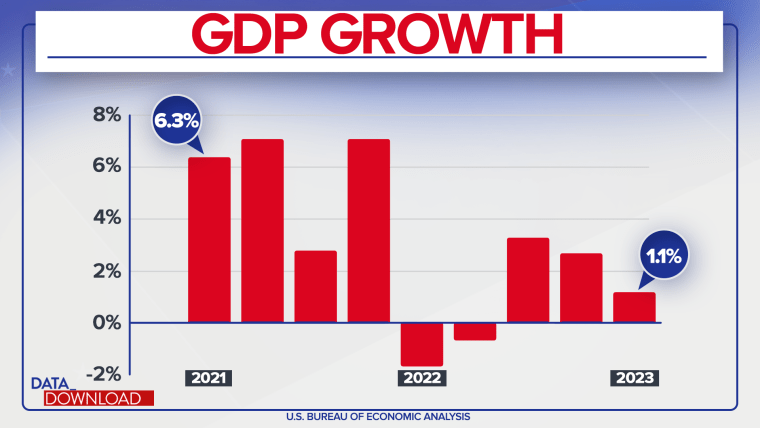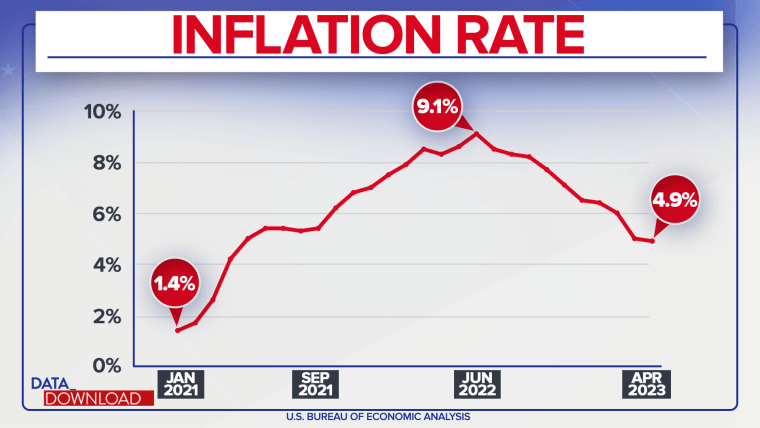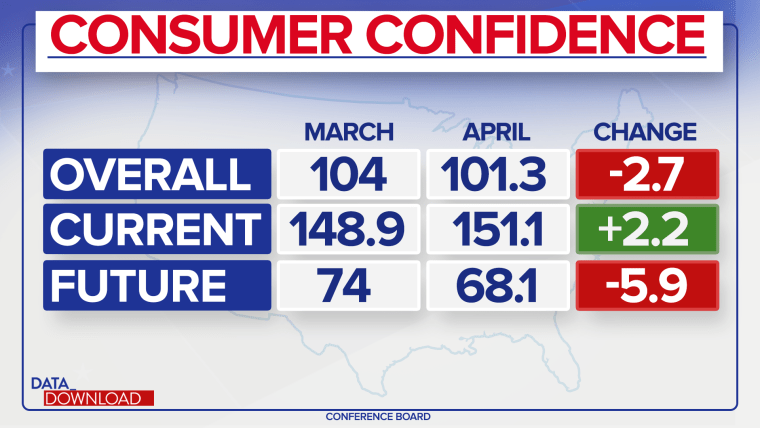WASHINGTON — The state of the US economy is a big driver of results in all elections. But going into the 2024 campaign cycle, there are more questions than tough answers about what it means for President Joe Biden’s re-election chances.
Is the economy “good” or “bad”? Better or worse? It depends on who you ask and of course if there is a «D» or an «R» next to their name. The data paints a complicated picture, one that seems to be more about where people think the economy is going than where it is right now.
Going by the broader measure: is the “economy growing or shrinking”? – the news is pretty good. Despite all the nail-biting about a looming recession, the gross domestic product data looks positive.

It has been difficult to measure economic health in the pandemic and post-pandemic world. The early days of the Biden administration were marked by rapid, even extreme, growth and a yo-yo pattern in numbers, as Covid vaccines and variants wreaked havoc on work schedules and office routines.
The extraordinary growth of 6.3 and 7 percent in the first two quarters of 2021 gave way to falls in the first two quarters of 2022.
However, since then, the numbers have looked a bit more stable and in the normal range. GDP grew 3.2% in the third quarter of 2022 and 2.6% in the fourth quarter. Early numbers for the first quarter of 2023 show a slowdown to 1.1% growth, but that’s still growth.
And frankly, the Federal Reserve Bank has been targeting slower growth (remember all those interest rate hikes) in hopes of preventing the economy from overheating and achieving a «soft landing.» The data suggests they just might, especially when you look at the economy through a different lens.
Consider unemployment. For many people, that question about the good or bad economy boils down to one question: are there jobs available for those who want to work? And the answer right now is an unequivocal yes.

The unemployment rate for April was 3.4%. That’s tied with January 2023 for the lowest rate in more than 50 years. And the unemployment rate among African Americans is at an all time low, at 4.7%.
The black unemployment rate has historically and consistently been higher than the overall unemployment rate, and it still is. But the gap between the overall jobless rate and the black jobless rate was just 1.3 percentage points in April. That’s lower than it was even in the summer of 2019, when African-American unemployment hit its pre-pandemic record low of 5.3%.
In short, those unemployment numbers are more than solid, they’re solid, and they certainly don’t suggest an economy slipping into recession.
Of course, the biggest cloud hanging over the economy from the Biden administration has been inflation. Conversations with voters are typically peppered with comments about higher monthly bills for everything from groceries to cars.
The latest data suggests that inflation is still a problem, but that it is declining.

When Biden took office and the economy was still largely frozen, inflation was at a barely perceptible 1.4%. The rate began to rise rapidly to the 5% range in the second half of 2021 as the economy geared up, and continued to climb with government spending, topping 6%, 7%, and even 8%. The inflation rate finally surpassed 9.1% in June last year.
But since then, it has been steadily falling. April’s 4.9% figure was the lowest since April 2021. It’s still not good news for consumers who feel they’re paying too much, but it does suggest that Washington has handled the problem, at least a little.
What do all those numbers mean to voters? That is not completely clear. Much of economics is psychology, what voters think about all the elements that go into it, and that gets complicated fast.
“Consumer confidence” measured by the conference board displays a mixed image.

Overall, consumer confidence fell slightly in April to a score of 101.3 from 104 in March. The reference number for the index in 100.
But when asked to assess the current state of the economy, the score rose in April compared to March, rising to 151.1 from 148.9 in March. That is, consumers felt better about the US economy in April than they did in March.
So what made the total number go down? Where do consumers think the economy is going? The «Expectations Index,» which measures where consumers think the economy will be in six months, fell to 68.1 in April from 74 in March.
That expectation number is significant for a number of reasons. First, when it’s below 80, it traditionally means a recession is expected next year. Second, the number has been below 80 every month since February 2022 (except for a brief sunnier sight in December 2022), and the US has yet to experience a recession.
In other words, it seems that much of the pessimism about the US economy is based on what people think it will do in the coming months, something that no one really knows.
There are reasons for concern, of course, starting with the great uncertainty that hangs over the fight for the debt ceiling. But consumer «expectations» are always something of a guessing game, and that’s doubly true in today’s strange economic environment.
And, in terms of politics, add this to the calculations: the 2024 election is more than 17 months away. At some point, we’ll find out if those consumer concerns about the future are met or faded. However, as they currently stand, many of the most important economic figures present, at worst, a mixed picture. And at best, things look pretty positive.

